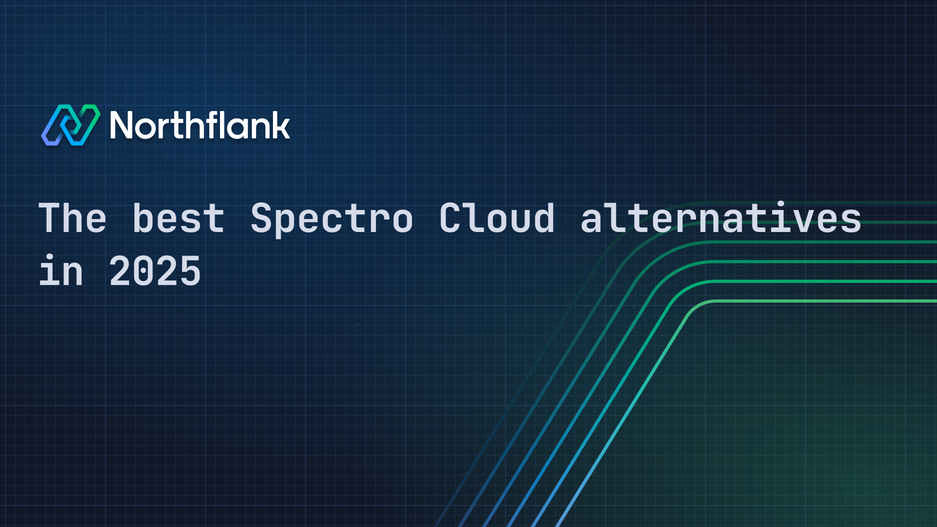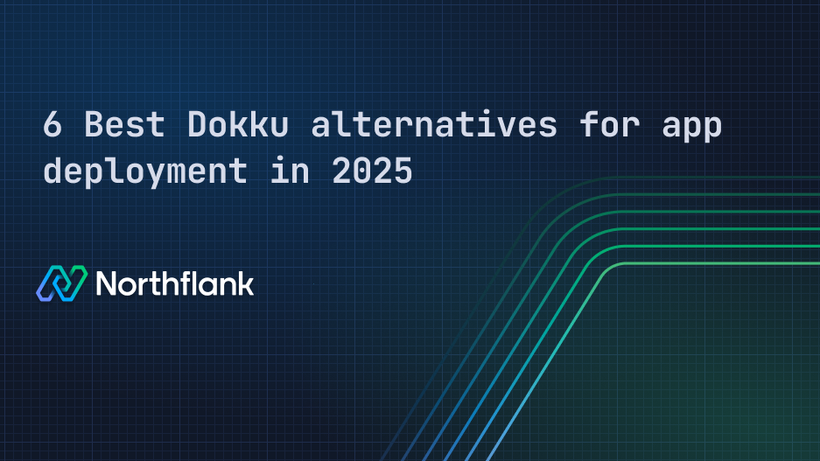

The best Spectro Cloud alternatives in 2025
You adopted Kubernetes because it promised control, consistency, and scale. Then you added Spectro Cloud to tame the complexity. A few months in, your team is spending more time tuning the platform than shipping features.
Your CI pipelines are fragmented. Secrets are duct-taped across environments. YAML is everywhere. And developers? They still need a platform engineer just to deploy a service.
You do not have a Kubernetes problem. You have a platform design problem.
If this sounds familiar, you are not alone. More teams in 2025 are walking away from heavy-handed platform stacks and toward tools that help them move faster without needing a PhD in DevOps.
This guide explores the best Spectro Cloud alternatives for teams that want to build and ship software, not just manage infrastructure. Whether you're a fast-moving startup or a platform team looking to reduce operational load, these seven options are worth your attention.
- Northflank – A developer-first Kubernetes platform with built-in CI/CD, databases, preview environments, and Git-based workflows. Abstracts away Kubernetes complexity without sacrificing control.
- Portainer – A UI-driven management tool for simplifying Kubernetes and Docker operations
- Platform9 – Managed Kubernetes for hybrid environments with SaaS convenience
- OpenShift – Enterprise-grade container orchestration with deep compliance support
- KubeSphere – Full-featured open-source platform for teams that want flexibility and depth
- Rancher – Battle-tested multi-cluster management with open-source roots
Spectro Cloud promises flexibility and control, and it delivers. But for many engineering teams, that control comes at a high cost: time, complexity, and context-switching.
The more you configure, the less you ship.
Product teams find themselves debugging YAML. Platform engineers juggle layers of abstraction. Developers wait for someone else to provision an environment. And the deeper you go into the Spectro stack, the harder it becomes to move fast or adapt.
The tradeoffs are starting to show:
- High operational overhead: Palette's power depends on heavy configuration and layered orchestration, meaning more time managing the platform, less time improving the product.
- Slower developer workflows: Spinning up a new service or environment often requires ticketing, scripting, and deep platform knowledge.
- Fragmented delivery pipelines: CI/CD, secrets, databases, and monitoring are all possible — but rarely native or frictionless.
- Developer experience is not a priority: Spectro Cloud was built for platform teams, not for the engineers writing and shipping code.
Teams are realizing that flexibility means little if it comes at the cost of momentum.
In 2025, speed is strategy. The platforms that win are the ones that reduce complexity, automate the boring stuff, and let developers focus on what actually moves the business forward — building.
If Spectro Cloud made Kubernetes manageable, the next wave of platforms is making it invisible.
A strong alternative doesn’t just expose more knobs. It rethinks the developer experience from first principles — removing unnecessary steps, automating operational overhead, and making delivery feel seamless.
The best platforms today are judged not by how many features they offer, but by how much cognitive load they eliminate.
Here’s what that looks like in practice:
-
Zero-to-deploy simplicity
Can a developer go from a Git repo to a running service in minutes, without writing YAML or opening a ticket?
-
Native delivery workflows
Does the platform integrate CI/CD, preview environments, rollbacks, and GitOps as first-class citizens, not bolt-ons?
-
Built-in infrastructure primitives
Are databases, background jobs, cron tasks, and secrets all part of the same cohesive experience?
-
Unified visibility and control
Can developers monitor logs, metrics, and resource usage in one place, without bouncing between tools?
-
Scalable by design, not effort
Can a small team scale to production confidently, without wrangling Helm charts or Terraform?
-
Flexible deployment targets
Does it support cloud, on-prem, hybrid, or multi-region setups with minimal friction?
Great platforms don’t just help you manage Kubernetes. They help you forget about it.
That’s the benchmark.
Looking for a simpler way to run Kubernetes? These alternatives to Spectro Cloud are making waves in 2025, each offering a fresh take on how teams build, deploy, and scale with less overhead.
Northflank is what Spectro Cloud wants to be for developers. It gives you all the power of Kubernetes—container orchestration, service discovery, and autoscaling—but wraps it in a developer-first experience.
No need to manage YAML files by hand. With Git-integrated workflows, built-in CI, automatic SSL, and managed databases, Northflank helps you go from code to running service in minutes. It also handles the heavy lifting like horizontal scaling, persistent storage, and background workers with a clean, intuitive UI and APIs.

Key features:
- Kubernetes-powered, full-stack platform
- Deploy containers, databases, and scheduled jobs
- Bring your own cloud (AWS, GCP, Azure, etc.)
- CI/CD integration, real-time logs, with a developer-friendly and consistent experience across UI, CLI, API, and GitOps
- GPU support for AI workloads
- Automatic preview environments and seamless promotion to dev, staging, and production
Best for:
- Dev teams building APIs, microservices, and containerized web apps
- SaaS products needing multi-service architectures
- Teams looking for a fast, clean alternative to older, more rigid platforms like Rancher
Potential drawbacks:
- Highly experienced DevOps teams might find it restrictive compared to directly managing raw Kubernetes clusters. It’s a fine balance between ease of use, flexibility, and customization; that line differs for every organization.
See how Weights company uses Northflank to scale to millions of users without a DevOps team
Portainer is a lightweight container management UI for Docker and Kubernetes environments. It’s not a full-fledged platform like others here, but it offers a user-friendly way to manage container infrastructure visually.

Key features:
- Simple dashboard for managing containers and clusters.
- Works with both Docker and Kubernetes.
- Role-based access control and team management.
- Minimal resource requirements.
Best for:
Self-hosters and small teams that want a visual layer over their existing container infrastructure.
Potential drawbacks:
- Lacks deeper DevOps features like CI/CD or GitOps.
- Not intended for large-scale enterprise workloads.
Platform9 is a managed Kubernetes solution designed for on-premises, edge, and hybrid cloud environments. Unlike fully cloud-hosted Kubernetes services, Platform9 allows organizations to run Kubernetes anywhere while benefiting from a SaaS-based management model.

Key features:
- Fully managed Kubernetes with a 99.9% uptime SLA.
- Works across on-prem, hybrid, and edge environments.
- Zero-touch upgrades and automated operations.
- Open-source foundation with no vendor lock-in.
Potential drawbacks:
- Smaller market share compared to OpenShift, which may affect long-term support.
- Reliance on a SaaS-based model may not be suitable for some enterprises.
OpenShift is a comprehensive Kubernetes platform developed by Red Hat. It’s designed for hybrid and multi-cloud deployments, offering strong security, compliance features, and enterprise support.

Key features:
- Full-stack Kubernetes with integrated developer tools.
- Native CI/CD with Tekton and support for pipelines.
- Robust RBAC, policy enforcement, and compliance capabilities.
- Deep integration with Red Hat Linux and other enterprise tools.
Best for:
- Large enterprises already invested in Red Hat infrastructure or needing high-security, compliance-ready Kubernetes environments.
Potential drawbacks:
- Complex to set up and maintain without dedicated platform teams.
- Can be resource-intensive and expensive.
KubeSphere is an open-source layer on top of Kubernetes that adds a dashboard and a suite of DevOps tools. It’s modular and flexible, especially for teams that already run their own clusters and want to gradually enhance them with UI and automation.

Key features:
- Visual interface for Kubernetes resource management
- Built-in support for CI/CD, observability, and multi-tenancy
- Pluggable architecture: enable only what you need
- Self-hosted and fully open-source
Best for:
- Teams already managing their own clusters
- Organizations comfortable maintaining infrastructure but wanting better UX
Potential drawbacks:
- Still requires ops knowledge to run and scale effectively
- UI is improving, but the overall experience can feel fragmented
- Lacks the end-to-end polish of a fully integrated platform.
Rancher is an open-source Kubernetes management platform that simplifies deployment and administration, especially in multi-cluster and multi-cloud environments. It provides centralized cluster management, making it ideal for enterprises running Kubernetes across multiple providers.

Key features:
- Easy cluster provisioning and lifecycle management.
- Built-in security, monitoring, and policy management.
- Supports on-premises, hybrid, and multi-cloud environments.
Potential drawbacks:
- Requires some Kubernetes expertise to configure and manage.
- May not have as extensive enterprise support as OpenShift.
Start with your team’s strengths and your goals. Consider these questions:
- Do we want to manage Kubernetes or abstract it away?
- How important is developer velocity?
- Do we need multi-cloud or hybrid support?
- How much customization do we want versus convenience?
If your focus is building software and delivering it fast, Northflank is designed exactly for that mission. If your team needs deep control, or is already embedded in a specific ecosystem like Red Hat or Jenkins, one of the other platforms may better fit.
Here is a quick comparison:
| Platform | Best For | Dev Experience | Ops Burden |
|---|---|---|---|
| Northflank | Full-stack app delivery | High | Low |
| Portainer | Visual cluster management | Medium | Medium |
| Platform9 | SaaS-managed hybrid infrastructure | Medium | Low |
| OpenShift | Enterprise compliance | Medium | High |
| KubeSphere | Open-source power users | Medium | High |
| Rancher | Multi-cluster ops | Low | Medium |
| Loft | Self-service for internal teams | Medium | Medium |
Spectro Cloud gave teams control. But in 2025, control isn't enough — not when you're shipping fast, scaling fast, and your developers are context-switching between YAML, dashboards, and custom tooling just to deploy a single service.
The best platforms today don’t just manage Kubernetes. They make it invisible.
If your team is tired of spending cycles on infra glue, if you're stitching together CI/CD pipelines, provisioning databases manually, or managing secrets through Slack threads, it’s time for a reset.
Northflank isn’t just a replacement for Spectro Cloud. It's a rethink. A platform designed to let you deploy faster, scale safely, and never touch YAML unless you want to.
Built for speed. Backed by infrastructure. Trusted by teams that ship.
Start building on Northflank and stop building your platform from scratch.

